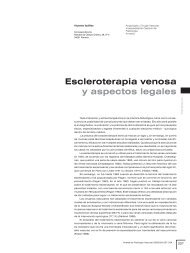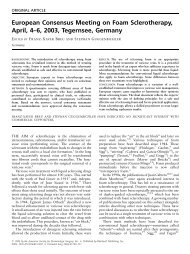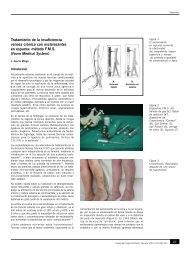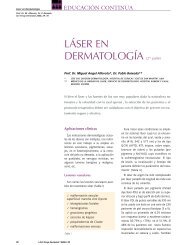The History of Sclerosing Foams
The History of Sclerosing Foams
The History of Sclerosing Foams
You also want an ePaper? Increase the reach of your titles
YUMPU automatically turns print PDFs into web optimized ePapers that Google loves.
700 WOLLMANN: THE HISTORY OF SCLEROSING FOAMS Dermatol Surg 30:5:May 2004<br />
Figure 8. Foam prepared with 3% polidocanol solution according to<br />
the double-syringe system (DSS). Sterile air or CO2 was used as gas.<br />
<strong>The</strong> degradation <strong>of</strong> foam is faster if CO2 is used instead <strong>of</strong> air and even<br />
more pronounced if the ratio is changed from 1:5 to 1:10.<br />
employed as the only gas—led to foams with quickly<br />
degrading bubbles (see Figure 8). Regarding the highdose<br />
treatment, more recent publications by Cabrera<br />
Garridos mentioned that the foam could flow from the<br />
greater saphenous vein into the deep venous system via<br />
the saphen<strong>of</strong>emoral junction or other connections,<br />
where it may provoke thromboses. 25 <strong>The</strong> number <strong>of</strong><br />
deep venous thromboses in a first study on this foam<br />
(6% thromboses when administering 20 mL <strong>of</strong><br />
Varisolve foam and more) 26 does not lend support to<br />
the high-dose foam therapy and requires special safety<br />
measures.<br />
1997—Alain Monfreux: 27 Low-Pressure<br />
Technique and ‘‘Méthode MUS’’<br />
Monfreux’s technique, published in 1997 under the<br />
name <strong>of</strong> ‘‘Méthode MUS,’’ was picked up primarily by<br />
French phlebologists. <strong>The</strong> principle was based on<br />
Gillesberger’s technique: generation <strong>of</strong> a negative<br />
pressure in the glass syringe filled with sclerosing<br />
solution, thus inlet <strong>of</strong> air through the fine gap between<br />
syringe barrel and plunger with corresponding pearling<br />
<strong>of</strong> the solution and transformation into a foam.<br />
Unlike Gillesberger, Monfreux generated an ‘‘absolute’’<br />
negative pressure by placing a cap on the syringe.<br />
Although all concentrations <strong>of</strong> sclerosants can be used<br />
with this method, the efficacy cannot be predicted in<br />
each individual case: a defined ratio <strong>of</strong> gas and<br />
sclerosant or a defined bubble size cannot be determined,<br />
because many variables (e.g., the width <strong>of</strong> the<br />
capillary gap between the syringe barrel and plunger,<br />
force, and duration <strong>of</strong> traction at the plunger and thus<br />
the order <strong>of</strong> magnitude <strong>of</strong> the effective shearing force<br />
which is responsible for the pearling <strong>of</strong> the solution)<br />
depend on the brand and on the user.<br />
1998—Symon Sadoun/Jean-Patric Benigni: 5,28<br />
Advanced Low-Pressure Technique<br />
Both authors improved Monfreux’s technique by<br />
making it usable for plastic syringes: <strong>The</strong> principle—<br />
generation <strong>of</strong> a negative pressure in a syringe closed by<br />
a Luer stopper—remained similar: pulling down the<br />
piston to generate subatmospheric pressure was<br />
followed by quickly releasing the piston several times.<br />
As with Monfreux and his predecessors, a defined<br />
gas:sclerosant ratio could not be stated.<br />
1998—Miguel Santos Gaston: 29 Advanced<br />
Low-Pressure Technique<br />
Gaston basically adopted the Monfreux technique, but<br />
added some more steps to the preparation procedure:<br />
once the foam was prepared according to Monfreux,<br />
he emptied the foam into a glass container and then<br />
aspirated the foam again. This was repeated several<br />
times, making—on the one hand—the foam more fine,<br />
but—on the other hand—more dry.<br />
1999—Javier Garcia Mingo: 30,31 High-Pressure<br />
Technique and ‘‘Foam Medical System’’<br />
Mingo was the first to describe a sterilizable, reusable<br />
device for the preparation <strong>of</strong> foam, which generates<br />
foam by the introduction <strong>of</strong> various gases from a<br />
pressure-gas cylinder and subsequent passage <strong>of</strong> the<br />
mixture through a fine nozzle, the ‘‘foam medical<br />
system.’’ <strong>The</strong> handling and cleaning <strong>of</strong> the device,<br />
which appears a little complicated, has prevented its<br />
wide use so far, although Mingo’s clinical results are<br />
considered very promising.<br />
2000—Lorenzo Tessari: 32,33 Double Syringes,<br />
Three-Way Tap, and the ‘‘Tourbillon Technique’’<br />
Tessari’s Tourbillon technique is at present, together<br />
with the similar DSS technique, the most commonly<br />
used technique. It corresponds basically to Irvine’s<br />
technique 24 but has clear advantages over the latter.<br />
Tessari uses two syringes as well (various sizes being<br />
described), but Tessari’s technique does not require<br />
‘‘foaming aids’’: <strong>The</strong> two syringes are connected by a<br />
three-way stopcock, and the sclerosing solution and air<br />
are drawn back and forth by pump movements. Owing<br />
to the absence <strong>of</strong> a connecting tube, a lot <strong>of</strong> disturbing<br />
silicone is no longer present. A more detailed<br />
description <strong>of</strong> the pumping procedure (at least 10<br />
times) to improve the standardization <strong>of</strong> the foam was<br />
given in 2001. 34<br />
<strong>The</strong> three-way stopcock has an additional ‘‘technical<br />
finesse’’: it is possible to vary the size <strong>of</strong> the passage






